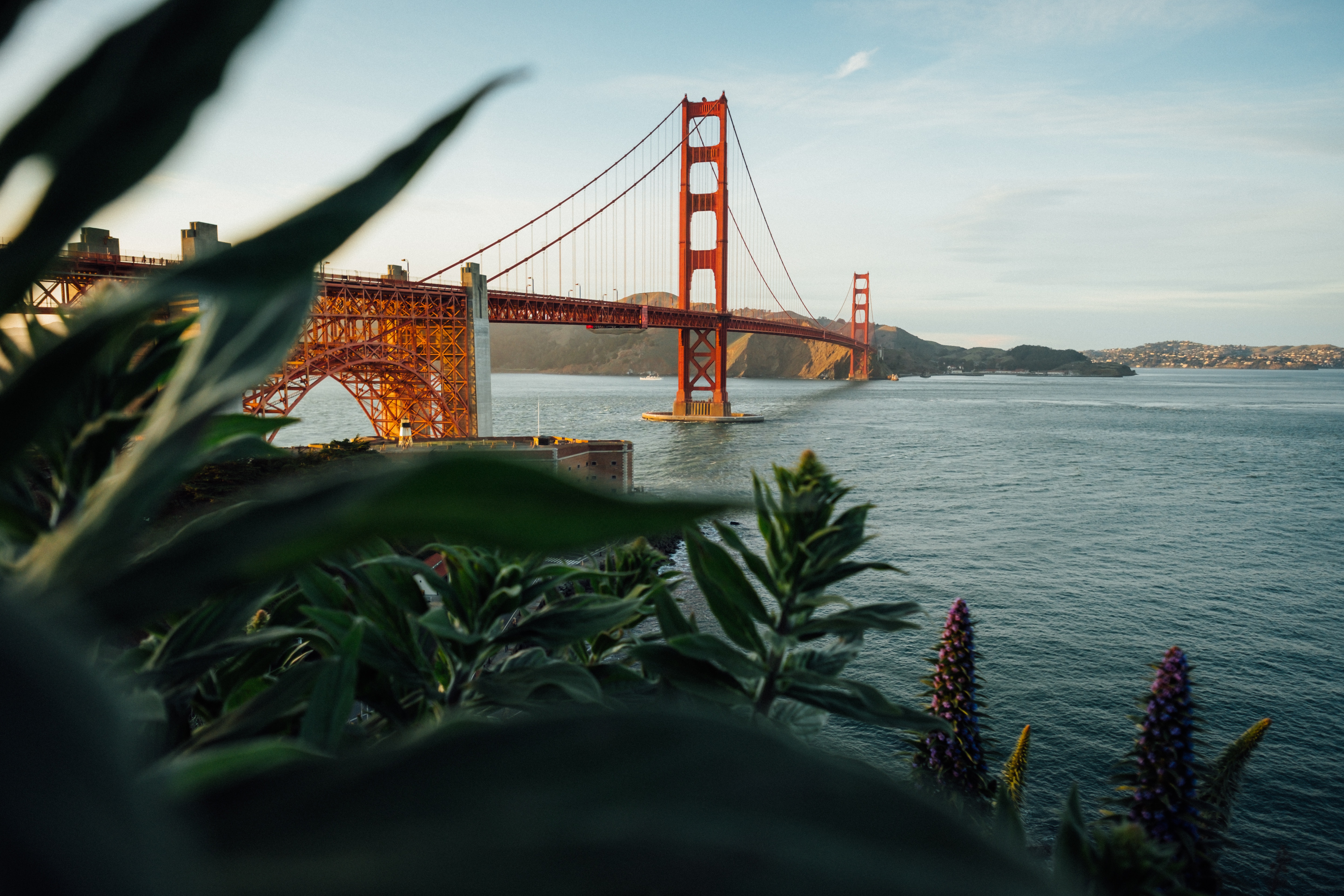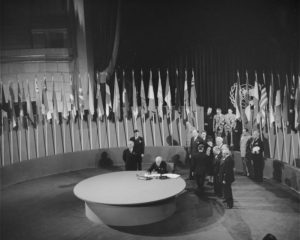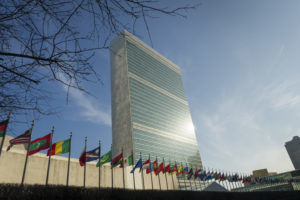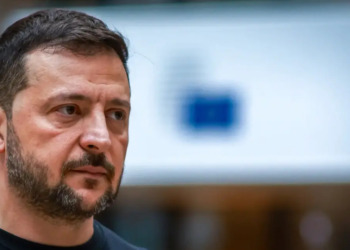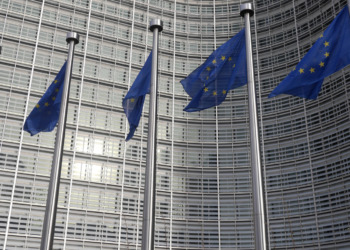Achieving sustainability, as both the City and County of San Francisco, began when the United Nations Conference on International Organizational met from April 25, 1945 to June 26, 1945, at the War Memorial Opera House and Veterans Building across from the City Hall. Fifty member nations coordinated by the United States, United Kingdom, Soviet Union, and Republic of China, drafted the United Nations Charter in a series of meetings at the Fairmont Hotel. The US Delegation held consultations with local civil society in the Garden Room. The United Nations Association was led by former leaders of the failed League of Nations and supported the vision expressed by Presudent Franklin D. Roosevelt in consultation with Prime Minister Winston Churchill to form the intergovernmental organization to prevent war as well as establish peace and security. A democratic process for consensus on the essential pillars of the United Nations Charter was reached. The United Nations Charter States as follows:
“We the peoples of the United Nations determined
to save succeeding generations from the scourge of war, which twice in our lifetime has brought untold sorrow to mankind, and
to reaffirm faith in fundamental human rights, in the dignity and worth of the human person, in the equal rights of men and women and of nations large and small, and
to establish conditions under which justice and respect for the obligations arising from treaties and other sources of international law can be maintained, and
to promote social progress and better standards of life in freedom.”
In the Photo: Edward Reilly Stettinius, Jr., Secretary of State, Chairman of the delegation from the United States, signing the UN Charter at a ceremony held at the Veterans’ War Memorial Building on 26 June 1945. At left is President Harry S. Truman. 26/Jun/1945. San Francisco, United States. Photo Credit: United Nations Photo
The United Nations Charter was signed on June 26, 1945, in the War Memorial Veterans Building Herbst Theater by fifty one sovereign countries representing all of the continents, thereby setting the path to the creation of the United Nations on October 24, 1945. The International Court of Justice was also established to enforce democracy and the rule of law.
President Roosevelt had wanted the UN Charter to be signed in Muir Woods. Sadly, he died before the conference adjourned. His memorial was held on May 19, 1945, among the towering 1,000 year-old redwood trees in what is now the Muir Woods National Monument.
San Francisco wanted to be the site of the United Nations Organization. The Presidio and Crystal Springs Reservoir were offered. Ultimately, the property in Manhattan was selected.
In the Photo: A view of the Secretariat Building, with Members States flags flying in the foreground, at United Nations headquarters in New York. Photo Credit: United Nations Photo
Today the War Memorial Veterans Building has been restored with $200,000 raised. It is now the place to confer about the United Nations Sustainable Development Goals (SDGs) and the Universal Declaration of Human Rights (UDHR). The United Nations Association, USA, San Francisco in partnership with the American Legion Post 315 are providing a platform for partnerships to achieve the global goals as they are based on human rights. Monthly conferences match Sustainable Development Goals with Articles of the Universal Declaration of Human Rights. Women in Technology, Achieving Gender Pay Parity, Universal Children’s Day, Ending FGM and Child Marriage, Refugees and Human Rights, Human Rights Education, Homelessness and Human Rights, and Climate Justice are addressed.
Program Sponsors include the leading UNA Chapters in the State of California, the International Rescue Committee, Human Rights Educators, San Francisco Status of Women Department, UNEP, Consulate General of Canada, Consulate General of Switzerland, San Francisco Collaborative Against Human Trafficking, San Francisco Human Rights Commission, and the UC Berkeley Law Human Rights Center.
Related Articles:
![]() “SAN FRANCISCO, CA: A LIVABLE FUTURE DESPITE ‘THE NEW ABNORMAL'”
“SAN FRANCISCO, CA: A LIVABLE FUTURE DESPITE ‘THE NEW ABNORMAL'”
by London Breed
![]() “WE CAN GET THERE FROM HERE: SUSTAINABILITY IN A CONSUMER-BESOTTED WORLD”
“WE CAN GET THERE FROM HERE: SUSTAINABILITY IN A CONSUMER-BESOTTED WORLD”
The United Nations Association, USA, San Francisco facilitates Collective Narratives harvested from Global Cafes in conjunction with expert panels. Patterns and clusters are identified to build partnerships. For example, the panel on the Intersection of the US State Department, USAID, NGOs, NPOs, Consultants, Social Entrepreneurs, and the United Nations for Humanitarian Aid led to the Young Professionals for Sustainable Seminar Series in Partnership with the University of San Francisco School of Management.
San Francisco civil society continues to thrive as it did in 1945. Women’s Rights were established as San Francisco adopted portions of the Convention to Eliminate All Forms of Discrimination in 1998. The Director of the San Francisco Status of Women Department consults with the United Nations Status of Women Commission. The Mayor’s Task Force on Anti-Human Trafficking coalesces government agencies, non governmental organizations such as the United Nations Association and non profit organizations to prevent violence and protect women and children from human trafficking. The UN Sustainable Development Goal #11 “Build Inclusive, Safe, and Sustainable Cities and Human Settlements” is being achieved.
In the Photo: United Nations Sustainable Development Goal #11. Photo Credit: United Nations
The target, 11.4 “Strengthen efforts to protect and safeguard the world’s cultural and natural heritage,” remains an ongoing effort. The conversion of military bases to the Golden Gate National Recreation Area was led by civil society, then followed by the establishment of the UNESCO Golden Gate Biosphere in 1988. The partnership to manage the 212,022 hectares includes the Muir Woods National Monument, Crystal Spring Reservoir, and the Presidio. The ecosystem ranges from marine, coastal, and upland resources accessible to the metropolitan San Francisco Bay Area. Three councils manage the following thirteen entities: Audubon Canyon Ranch, University of California, National Oceanic and Space Administration, US Fish and Wildlife Service, National Park Service, Stanford University, Marin Municipal Water District, California Department of Parks and Recreation, San Francisco Public Utilities Commission, Point Reyes Bird Observatory, and Presidio Trust.
As the population of San Francisco doubles on the week days, the need to oversee the natural resources such as the fisheries remains eminent. Risks to the ecosystems from pollutants and invasive species as well as catastrophic events such as fires and climate extremes require international collaboration. The Golden Gate Biosphere Reserve cooperates with the Iroise Biosphere Reserve in France.
The golden opportunities for becoming self-sustaining through the protection of human rights still draws ‘We the peoples’ together. Elected and appointed officials resemble members of the United Nations General Assembly as San Francisco achieves sustainability.
Local indigenous peoples remain throughout the San Francisco Bay Area. The earliest known human settlements were the Muwekma Ohlone Tribe. The arrival of Spanish missionaries and military in 1776 started a registry of the indigenous families which is utilized today. Wave after wave of immigrants and refugees continue to diversify the local culture. The golden opportunities for becoming self-sustaining through the protection of human rights still draws “We the peoples” together. Elected and appointed officials resemble members of the United Nations General Assembly as San Francisco achieves sustainability.


